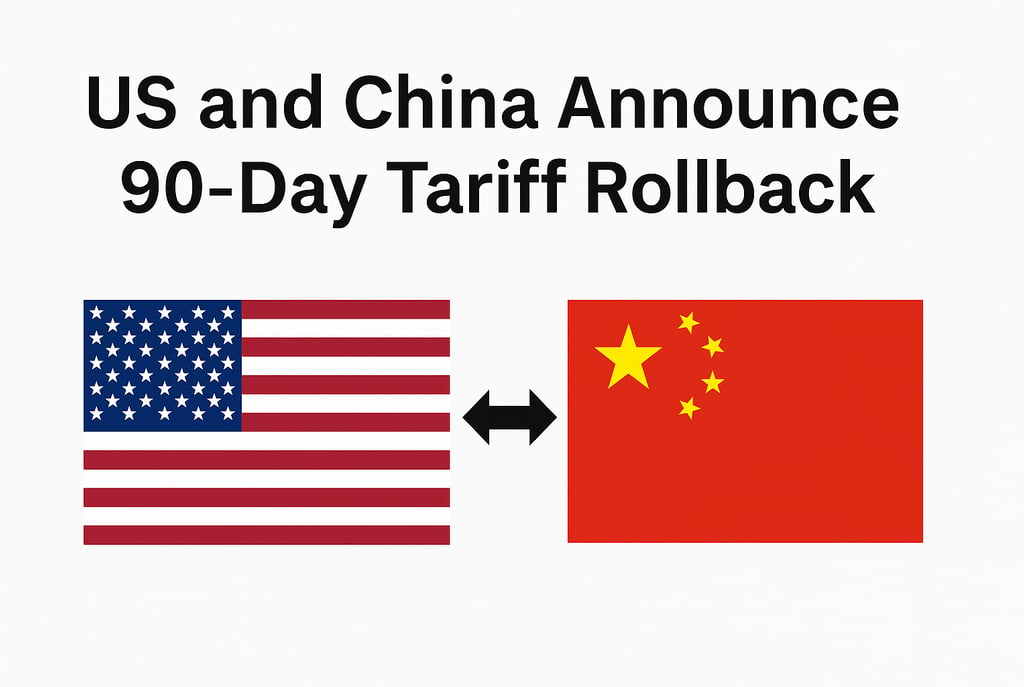US China Trade Deal 2025: 90-Day Tariff Rollback Announced
SD
5/12/20253 min read


US and China Announce 90-Day Tariff Rollback: What It Means for Global Trade (May 2025 Update)
In a surprise diplomatic breakthrough, the United States and China have jointly announced a 90-day agreement to roll back a significant portion of tariffs levied during their ongoing trade standoff. This development resets the tone between the world’s two largest economies and provides temporary relief for global markets, supply chains, and consumers.
The decision was finalized after intense negotiations held over the weekend in Geneva, Switzerland, and was publicly announced on May 12, 2025.
What Was Announced?
As per the joint statement:
The United States will lower its tariffs on Chinese imports from 145% to 30%
China will cut its tariffs on US goods from 125% to 10%
The agreement applies for 90 days, beginning May 14, 2025
Both countries agreed to suspend non-tariff barriers such as blacklists and import inspections during this window
This move is being interpreted by analysts as a “tariff truce,” aimed at de-escalating trade tensions and reestablishing diplomatic engagement.
Immediate Market Reactions
The announcement triggered a surge in global financial markets:
S&P 500 rose by 2.5%
Nasdaq jumped 3.3%
Shipping giants like Maersk saw a 12% stock surge
Gold prices dropped by 3.1%, reflecting improved investor confidence
Bond markets, however, remained cautious due to the temporary nature of the truce
The Indian stock market also responded positively, with Nifty and Sensex closing higher amid reduced uncertainty in global trade.
Economic and Strategic Implications
While this rollback represents a significant step, it is widely viewed as temporary relief, not a long-term solution.
Key takeaways:
Supply chains may resume, but with difficulty. Restarting furloughed factories, sourcing materials, and shipping inventory will take time.
Importers may advance Q3/Q4 shipments to take advantage of lower tariffs, potentially stressing freight capacity.
Tariffs are still high (30% for US-bound Chinese goods), so pricing pressures will continue, especially on consumer electronics, industrial parts, and automotive imports.
Investments remain delayed, as businesses await a more permanent agreement.
US domestic banks see this as a positive move but remain cautious due to macroeconomic uncertainty.
Impact on Supply Chains
Supply chain experts warn that while a 90-day reprieve may allow paused shipments to resume, the broader logistics ecosystem may not recover immediately. Many Chinese manufacturers had laid off workers, canceled orders, or shifted capacity to other markets. Reactivating these networks is not instantaneous.
Additionally, some US importers are likely to front-load inventory, further congesting ports and warehousing operations by early Q3 2025.
Geopolitical Significance
This truce is significant not just economically but politically. It shows both countries are responding to domestic and international pressure to de-escalate tensions that were beginning to have global consequences. Diplomats suggest that this move may set the stage for a more comprehensive agreement later in the year.
However, officials also made it clear that unresolved issues remain on:
Intellectual property rights enforcement
Access to markets for fintech and pharmaceutical companies
Ongoing disputes over cybersecurity and AI export controls
What Comes Next?
The 90-day agreement is not automatic renewal. Its continuation depends on further negotiations scheduled in Washington and Beijing through July.
Possible outcomes:
If progress is made, a Phase 2 agreement may be signed with longer-term tariff adjustments
If talks stall, previous tariffs may return, risking market disruption
Both nations are expected to monitor compliance weekly, adding pressure on negotiators
Conclusion
The tariff rollback is a welcomed development in an otherwise hostile trade environment, offering a narrow window for businesses, investors, and governments to adjust. But its short duration leaves little time for structural shifts. It is a pause, not a peace treaty.
With supply chains, inflation, consumer prices, and geopolitical tensions hanging in the balance, all eyes are now on the July deadline.
Stakeholders — from importers and retailers to logistics firms and investors — must remain flexible, watch key signals, and prepare for both resolution and re-escalation scenarios.
About One Solution
Quick Links
Contact Info
One Solution — Your trusted partner for financial success.
📍 F17, Grand Plaza, Paltan Bazar
Guwahati, Kamrup (M), Assam
India, Pin: 781008
📞 9650072280
© 2025 One Solution. All Rights Reserved.
